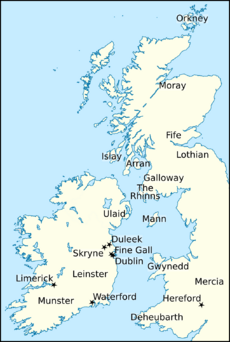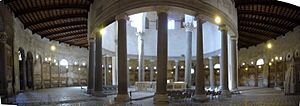Echmarcach mac Ragnaill facts for kids
Quick facts for kids Echmarcach mac Ragnaill |
|
|---|---|
| King of Dublin and the Isles | |

Echmarcach's name as it appears on folio 17r of Oxford Bodleian Library Rawlinson B 488 (the Annals of Tigernach): "Eachmarcach".
|
|
| King of Dublin | |
| Reign | 1036–1038 |
| Predecessor | Sitriuc mac Amlaíb |
| Successor | Ímar mac Arailt |
| King of Dublin | |
| Reign | 1046–1052 |
| Predecessor | Ímar mac Arailt |
| Successor | Diarmait mac Maíl na mBó |
| Died | 1064/1065 Rome |
| Issue | Mór |
| House | probably Uí Ímair |
Echmarcach mac Ragnaill (died 1064/1065) was a very important leader in the Irish Sea area during the 1000s. At his most powerful, he was king of Dublin, the Isles, and possibly even Galloway.
We aren't completely sure who Echmarcach's father, Ragnall, was. He might have been a ruler from Waterford or a king of the Isles. If so, Echmarcach could have been part of the powerful Uí Ímair family.
Echmarcach first appears in history around 1031. He was one of three kings who met with King Knútr of the Anglo-Scandinavian Empire. Echmarcach ruled Dublin from 1036 to 1038 and again from 1046 to 1052. After losing Dublin for good, he seems to have ruled from the Isle of Man. In 1061, he was forced out of the Isles and might have gone to Galloway.
Echmarcach made an alliance with the strong Uí Briain family. His daughter, Mór, married into this family. Echmarcach's life was full of battles, especially with another branch of the Uí Ímair family who often ruled Dublin. This rival family was supported by the rising Uí Cheinnselaig group, who eventually kicked Echmarcach out of Dublin and the Isle of Man.
Around 1064, Echmarcach went on a pilgrimage to Rome with Donnchad, who was also a deposed king. Echmarcach was about 65 years old when he died in Rome, either in 1064 or 1065. After his death, the Uí Briain family used Echmarcach's descendants to control Dublin and the Isles. One of his grandsons even became a king.
Contents
Who was Echmarcach's Family?
Echmarcach was the son of a man named Ragnall. Echmarcach's name is Gaelic, but his father's name, Ragnall, comes from Old Norse. This shows how mixed the cultures were in the Irish Sea region during the 1000s.
We don't know for sure who Echmarcach's father was.
- One idea is that Ragnall was from the family that ruled Waterford. If so, Echmarcach might have been the son of Ragnall mac Ímair or Ragnall ua Ímair.
- Another idea is that Echmarcach was from a family in the Isles. His father could have been Ragnall mac Gofraid, King of the Isles.
If any of these are true, Echmarcach would have been part of the Uí Ímair royal family. This family came from the famous Viking sea-king Ímar.
Echmarcach and King Knútr
Meeting the Three Kings
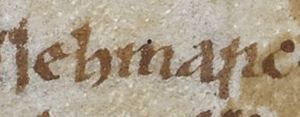
Echmarcach first appears in history in the early 1000s. He was one of three kings who met with King Knútr. Knútr ruled a huge empire that included Denmark, England, and Norway.
A poem from that time, Knútsdrápa, mentions this meeting in Fife, Scotland. The Anglo-Saxon Chronicle also talks about it. It says Knútr went to Scotland in 1031 and received the submission of three kings. These kings were "Mælcolm," "Mælbæþe," and "Iehmarc."
- "Mælcolm" was Máel Coluim mac Cináeda, King of Scotland.
- "Mælbæþe" was Mac Bethad mac Findlaích, who later became the famous Macbeth.
- "Iehmarc" was Echmarcach himself.

Máel Coluim was likely the most powerful of the three. Mac Bethad and Echmarcach might have been kings who reported to him. Mac Bethad became the ruler of Moray in 1032. This might explain why he was called a king when he met Knútr.
There's some confusion about the exact date of this meeting. The Anglo-Saxon Chronicle says 1031, but Knútr is known to have visited Rome in 1027. It's possible the chronicle got the date wrong.
Another old source, Historiarum libri quinque, says Knútr fought a long war with Máel Coluim before 1030. This war ended with the help of Knútr's wife, Emma. This suggests Knútr was involved in Scottish affairs for a while.
Echmarcach meeting with Máel Coluim and Mac Bethad suggests he was a "Scottish" ruler. His power base was likely in the Isles. This supports the idea that he was a descendant of Ragnall mac Gofraid. Máel Coluim's influence in the Isles is also suggested by old texts. One source says he lived or had power in the Hebrides.

The death of Suibne mac Cináeda in 1034 is also recorded. He was called "king of the Gall-Gaidheil," meaning "Stranger-Gaels." This term referred to people of mixed Scandinavian and Gaelic heritage in the Hebrides. Máel Coluim and Suibne died in the same year and had similar names, suggesting they might have been brothers. If so, Máel Coluim might have put Suibne in charge of an area with Scandinavian settlers. This could mean Máel Coluim was the overlord of the Isles at that time.
Why Did They Meet?

The reason for the meeting of the four kings is not clear.
- It might have been related to Máel Coluim taking over Lothian.
- It could also be because of the violent change in power in Moray, which put Mac Bethad in charge. Knútr might have wanted to ensure peace between Echmarcach, Máel Coluim, and Mac Bethad.
- Another idea is that Máel Coluim wanted Knútr to stay neutral in a fight against Mac Bethad. He might also have wanted naval support from Echmarcach.
Knútr probably wanted to protect his northern borders. He also wanted to stop these kings from helping anyone who might challenge his rule. If Echmarcach was related to Lagmann mac Gofraid, who had helped Knútr's enemy Óláfr Haraldsson, then Knútr might have wanted to prevent Echmarcach from allying with his rivals.
Knútr and Óláfr were enemies. In 1028, Knútr defeated Óláfr and took control of Norway. Knútr's nephew, Hákon Eiríksson, was made regent there. But Hákon died at sea in 1029 or 1030. About three years later, a man named Tryggvi Óláfsson challenged Knútr's rule in Norway. Tryggvi had connections to Dublin and the Isles. He was killed, but this shows how threats to Knútr could come from the Viking settlements in Britain and Ireland.

Rulers of Orkney also had ties to Óláfr's family, which could have threatened Knútr. The meeting with the three kings might have been a way to stop Orkney's power from spreading. Knútr might have wanted to prevent Orkney from getting involved in Norway. The Earl of Orkney, Þórfinnr Sigurðarson, Earl of Orkney, was even fighting with Mac Bethad. Old sagas suggest Þórfinnr was very active in the Isles, Galloway, and Dublin.
Knútr might have taken other steps to control Orkney. Some sources suggest Knútr made Hákon the overlord of the Isles. If Hákon had indeed ruled the Isles, his death would have been a big problem for Knútr. It might have opened the way for Echmarcach to rise to power. After making peace with the three kings, Knútr might have relied on Echmarcach to counter Orkney's ambitions in the Isles.
Alliances and Taking Over Dublin
| Simplified family tree illustrating familial connections between Echmarcach and the Uí Briain kindred. Women are italicised. It is uncertain how or if Cacht ingen Ragnaill was related to Echmarcach. Diarmait mac Maíl na mBó and his son Murchad were opponents of Echmarcach, whilst Donnchad mac Briain appears to have accompanied Echmarcach upon a pilgrimage. | ||||||||||||||||||||||||||||||||||||||||||||||||||||||||||||||||||||||||||||||||||||||||||||||||||||||||||||||||||||||||||||||||||||||||||||||||||||||||||||||||||||||||||||||||||||||||||||||||||||||||||||||||||||||||||||||||||||||||||||||||||||||||||||||||||||||||||||||||||||||||||||||||||||||||||||||||||||||||||||||||||||||||||||||||||||||||||||||||||||||
|---|---|---|---|---|---|---|---|---|---|---|---|---|---|---|---|---|---|---|---|---|---|---|---|---|---|---|---|---|---|---|---|---|---|---|---|---|---|---|---|---|---|---|---|---|---|---|---|---|---|---|---|---|---|---|---|---|---|---|---|---|---|---|---|---|---|---|---|---|---|---|---|---|---|---|---|---|---|---|---|---|---|---|---|---|---|---|---|---|---|---|---|---|---|---|---|---|---|---|---|---|---|---|---|---|---|---|---|---|---|---|---|---|---|---|---|---|---|---|---|---|---|---|---|---|---|---|---|---|---|---|---|---|---|---|---|---|---|---|---|---|---|---|---|---|---|---|---|---|---|---|---|---|---|---|---|---|---|---|---|---|---|---|---|---|---|---|---|---|---|---|---|---|---|---|---|---|---|---|---|---|---|---|---|---|---|---|---|---|---|---|---|---|---|---|---|---|---|---|---|---|---|---|---|---|---|---|---|---|---|---|---|---|---|---|---|---|---|---|---|---|---|---|---|---|---|---|---|---|---|---|---|---|---|---|---|---|---|---|---|---|---|---|---|---|---|---|---|---|---|---|---|---|---|---|---|---|---|---|---|---|---|---|---|---|---|---|---|---|---|---|---|---|---|---|---|---|---|---|---|---|---|---|---|---|---|---|---|---|---|---|---|---|---|---|---|---|---|---|---|---|---|---|---|---|---|---|---|---|---|---|---|---|---|---|---|---|---|---|---|---|---|---|---|---|---|---|---|---|---|---|---|---|---|---|---|---|---|---|---|---|---|---|---|---|---|---|---|---|---|---|---|---|---|---|---|---|---|---|
|
||||||||||||||||||||||||||||||||||||||||||||||||||||||||||||||||||||||||||||||||||||||||||||||||||||||||||||||||||||||||||||||||||||||||||||||||||||||||||||||||||||||||||||||||||||||||||||||||||||||||||||||||||||||||||||||||||||||||||||||||||||||||||||||||||||||||||||||||||||||||||||||||||||||||||||||||||||||||||||||||||||||||||||||||||||||||||||||||||||||
After meeting Knútr, Echmarcach seems to have allied with the Uí Briain family. This family were descendants of the famous Brian Bóruma mac Cennétig, High King of Ireland. In 1032, Donnchad mac Briain, King of Munster married a woman named Cacht ingen Ragnaill. Her father was also named Ragnall.

Like Echmarcach, Cacht's father's name suggests she was related to the Ragnalls of Waterford or Ragnall mac Gofraid. She might have been Echmarcach's sister or niece. Donnchad wanted to become the High King of Ireland. With Echmarcach's strong navy, he would have been a valuable ally.
There is clear proof of this alliance. Echmarcach's daughter, Mór, married Tadc, the son of Toirdelbach Ua Briain. This alliance continued for a long time. One of Echmarcach's grandsons, Domnall mac Taidc, even became King of the Isles around the 1100s.
If Echmarcach was Ragnall mac Gofraid's son, this alliance would have been a continuation of good relations between the families. Ragnall mac Gofraid's father had joined forces with Brian Bóruma in 984. Ragnall mac Gofraid himself died in Munster, the Uí Briain heartland.

In 1036, Echmarcach took over Dublin from Sitriuc mac Amlaíb. Sitriuc was the son of Amlaíb Cuarán. Old records say Sitriuc fled overseas when Echmarcach took control. Echmarcach's alliance with Donnchad likely helped him seize Dublin. Donnchad and Sitriuc were half-brothers, but Donnchad had attacked Dublin in 1026.
Another reason for Echmarcach's attack on Sitriuc might be Knútr's death in 1035. Knútr and Sitriuc had worked together in trade and military actions. Echmarcach's relationship with Knútr was not as friendly. It's possible that Knútr's death created a power vacuum. Echmarcach might have used this chance to take control of the Irish Sea region.
A poet from that time, Óttarr svarti, said Knútr ruled Danes, Englishmen, Irishmen, and Islesmen. The Irish likely referred to the Dubliners. This suggests Knútr had some authority over Sitriuc. Sitriuc's ability to go on a pilgrimage in 1028 and return to his kingdom shows Knútr's influence in the Irish Sea. This influence might have kept Sitriuc safe during Knútr's reign.

If Echmarcach was from the Waterford family, his attack on Sitriuc could be part of a long rivalry between Dublin and Waterford. It might have been revenge for Sitriuc killing Ragnall ua Ímair, the King of Waterford, the year before.
We don't know much about Echmarcach's first short rule in Dublin. He attacked Skryne and Duleek in 1037. This might have been an attempt to regain control of areas Dublin was losing. Sitriuc didn't go to the Isle of Man after being expelled. This suggests Echmarcach might have already controlled the island. He might have even used the Isle of Man as a base to take over Dublin.
Conflicts in the Isles, Ireland, and Wales

Þórfinnr's power in the Isles suggests he was interested in the fight for Dublin. His raids in the Irish Sea region might have caused Echmarcach to lose Dublin in 1038. Just as Echmarcach used Knútr's death to expand, Þórfinnr might have used the power vacuum to attack the Irish Sea region.
Records show that Ímar mac Arailt replaced Echmarcach as King of Dublin that year. This means Echmarcach was forced out. Ímar was likely a descendant of Amlaíb Cuarán, and thus related to Sitriuc, whom Echmarcach had removed. Ímar might have had support from Knútr's son, Haraldr Knútsson, King of England. Ímar's campaigns in the North Channel suggest Echmarcach had power there before Dublin. Ímar's rule lasted eight years. In 1046, Echmarcach expelled Ímar and became king of Dublin again.

Echmarcach probably controlled the Isle of Man during his second rule in Dublin. Silver hoards found on the Isle of Man from the 1030s–1050s show intense conflict there. There's also evidence that a mint operated on the Isle of Man around this time. Coins minted there look like Dublin coins. This suggests Echmarcach tried to unify the money in his kingdom. The wealth and trade in Echmarcach's realm explain why the fight for Dublin and the Isles was so fierce.
During his second reign, Echmarcach might have been involved in military actions in Wales with Gruffudd ap Rhydderch. In 1049, Norse-Gaelic forces helped Gruffudd ap Rhydderch fight his Welsh rivals and English neighbors. They sailed up the River Usk and attacked the area. They also defeated English forces.
Echmarcach's large kingdom across the Irish Sea might have been seen as a threat by Siward, Earl of Northumbria. Siward was an Anglo-Danish earl who expanded his power into the Kingdom of Strathclyde. Echmarcach's connection to the Uí Ímair, who once ruled York, and his growing power after Knútr's death, would have worried Siward. This might explain Siward's expansion into the Solway region, an area Echmarcach might have seen as vulnerable.
Losing Dublin and Mann

In 1052, Diarmait drove Echmarcach out of Dublin. This event is recorded in several old texts. They say Diarmait's attack started as a raid but quickly turned into a full takeover of Dublin. After some fights around the town's fortress, Echmarcach fled overseas, and Diarmait became king.
With Diarmait's victory, Norse-Gaelic Dublin lost its independence in Ireland. When Diarmait and his son, Murchad, died about twenty years later, Irish rule over Dublin was stronger than ever before. Dublin became the capital of Leinster, and Diarmait gained its wealth and military power.
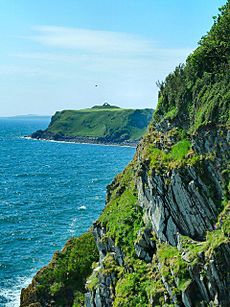
In 1054, Ímar mac Arailt was called "king of the foreigners" when he died. This might mean Diarmait put him back in charge of Dublin after Echmarcach was expelled. Murchad seems to have become king by 1059. He was an active ruler. In 1061, he launched a successful sea invasion of the Isle of Man. Old records say Murchad collected a tax from the Isle of Man and that a "son of Ragnall" was driven from the island.
Collecting cáin (tribute) was a right of kingship in Ireland. Murchad collecting tribute from the Manx suggests he saw himself as the rightful ruler of the Isle of Man. If the "son of Ragnall" was Echmarcach, it means Echmarcach had settled on the island after being expelled from Dublin. Another possibility is that Echmarcach only became king in the Isles again after Ímar mac Arailt's death in 1054.
Magnús Haraldsson and Ælfgar Leofricson
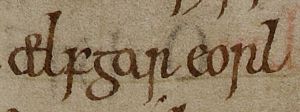
In 1055, an English nobleman named Ælfgar Leofricson was exiled from England. He went to Ireland and received a lot of military help. He formed a fleet of eighteen ships and, with Gruffudd ap Llywelyn, King of Gwynedd and Deheubarth, invaded Herefordshire.
This campaign helped Ælfgar get his position back. But in 1058, Ælfgar was exiled again. He then allied with Gruffudd ap Llywelyn and a Norse fleet. Old Irish records say the fleet's leader was Magnús, son of Haraldr Sigurðarson, King of Norway. His forces included people from Orkney, the Isles, and Dublin.
We don't know exactly who helped Ælfgar in the Irish Sea region. It's possible he got help from Dublin, which was then ruled by Murchad (with Diarmait as overlord). Since Diarmait had driven Echmarcach from Dublin and the Isle of Man, the joint campaign of Ælfgar and Magnús in 1058 might have involved Diarmait. However, Diarmait seems to have helped Ælfgar's enemies, the Godwinsons, at other times.
It's not clear who Ælfgar's Irish ally was in 1055. It's possible he got help from Donnchad, Diarmait's enemy and Echmarcach's friend. Donnchad controlled Limerick and possibly Waterford. Also, even though Diarmait gained control of the Isle of Man by 1061, Echmarcach probably still ruled parts of the Hebrides in 1058. Since Magnús used Islesmen in his campaign, Echmarcach might have been involved. If so, Echmarcach and Diarmait were unlikely to have worked together.
Magnús's reason for helping Ælfgar is uncertain. He might have been trying to establish Norwegian power in the west to prepare for an invasion of England. He might have supported a local group that opposed Echmarcach. The Chronicle of Mann records that Gofraid Crobán, a future ruler of Dublin and the Isles, supported Magnús's father's invasion of England in 1066.
Pilgrimage and Death in Rome
In 1064, Echmarcach seems to have gone on a pilgrimage to Rome with Donnchad. Both were likely old by this time. They both died in Rome soon after. Records give different dates for Echmarcach's death, either 1064 or 1065. Many sources say Donnchad died in 1064 after his pilgrimage to Rome. Several sources say Donnchad died at Santo Stefano Rotondo, an old church on the Caelian Hill. This church was an important pilgrimage site and likely housed Echmarcach and Donnchad before they died.
Pilgrimages like theirs were common for high-ranking Gaelic and Norse-Gaelic leaders. Many important figures died while on pilgrimages to Rome. If Echmarcach was the son of Ragnall mac Gofraid and was born shortly before his father's death, he would have been about 65 when he died.

One old text calls Echmarcach "rex Innarenn." This might be a confused way of saying "King of the Isles." If so, other titles like "king of the foreigners" given to him in 1064 would mean he was still seen as the ruler of the Isle of Man.
However, "rex Innarenn" could also mean "King of the Rhinns," referring to the Rhinns of Galloway. This region stretched from the North Channel to Wigtown Bay. Earlier, it might have been part of Sitriuc's kingdom. It might have been held by one of Sitriuc's sons named Amlaíb.
If Echmarcach was Ragnall mac Gofraid's son and took over in the 1030s, he might have first gained control of the Rhinns when he started dominating the Irish Sea region in 1036. Even if this is true, his rule in the Rhinns might have come from his new position in Dublin, not from his family. If "rex Innarenn" refers to the Rhinns, it could mean that after Murchad defeated Echmarcach on the Isle of Man, Echmarcach fled to this mainland region. If Echmarcach was from what is now southwest Scotland, this title could mean that he retreated to his homeland after his large kingdom collapsed.
Margaðr and Guthormr Gunnhildarson
Echmarcach has sometimes been confused with a person named Margaðr. Margaðr appears in old stories about his adventures in the Irish Sea with Guthormr Gunnhildarson. One story, Haralds saga Sigurðarsonar, says Margaðr was King of Dublin and a friend of Guthormr. Guthormr was the nephew of the Norwegian kings Óláfr and Haraldr Sigurðarson.
One summer, the story says Margaðr and Guthormr had a very successful raid in Wales. When they were dividing their silver loot, Margaðr demanded Guthormr's share. This forced Guthormr to fight for his portion. Even though Guthormr was outnumbered, he defeated and killed Margaðr and his followers. The story says this happened because of a miracle from God and Guthormr's saintly uncle, Óláfr.
This battle between Margaðr and Guthormr is sometimes dated to 1052. This is because people thought Margaðr was Echmarcach, and the event happened when Echmarcach lost Dublin for the second time. However, the Old Norse name Margaðr is actually a form of the Gaelic name Murchad. So, the stories about Margaðr likely refer to Echmarcach's enemy, Murchad, not Echmarcach himself.
The saga says Guthormr donated some of his looted silver to the shrine of his saintly uncle, Óláfr. But it's unlikely a church would accept stolen property from Christians. Instead, Guthormr's silver might have been the tax that Murchad collected from the Isle of Man in 1061 when Echmarcach was expelled. This date fits with the implied date of around 1061 in Heimskringla.
Images for kids
-
Depiction of Knútr as it appears on folio 6r of British Library Stowe 944.
-
The name of Máel Coluim mac Cináeda as it appears on folio 16v of Oxford Bodleian Library Rawlinson B 488: "Mael Colaim mac Cínaetha". Máel Coluim reigned as King of Scotland from 1005 to 1034, and may have been an overlord or opponent of Echmarcach.
-
The name of Suibne mac Cináeda as it appears on folio 16v of Oxford Bodleian Library Rawlinson B 488: "Suibne mac Cinaetha". Suibne was a neighbouring contemporary of Echmarcach. The latter's dealings with the three kings could indicate he and Suibne were rivals along the western seaboard of Scotland.
-
The name of Mac Bethad mac Findlaích as it appears on folio 41v of Oxford Bodleian Library Rawlinson B 489 (the Annals of Ulster). Mac Bethad was a powerful figure in north-eastern Scotland.
-
The name of Hákon Eiríksson as it appears on folio 11v of AM 325 II 4to (Ágrip af Nóregskonungasǫgum): "Hǫ́kon".
-
The name and title of Cacht ingen Ragnaill as they appear on folio 18r of Oxford Bodleian Library Rawlinson B 488: ("Cacht ingen Ragnaill, rígan Erenn"). This source styles Cacht "Queen of Ireland", which could reveal the affection that her husband, Donnchad, felt for her.
-
The name of Sitriuc mac Amlaíb as it appears on folio 16v of Oxford Bodleian Library Rawlinson B 488: "Sitriuic mac Amlaim".
-
The name of Ragnall ua Ímair, a member of the Waterford dynasty slain in 1035, as it appears on folio 39r of Oxford Bodleian Library Rawlinson B 489.
-
The name and title of Echmarcach's opponent Ímar mac Arailt as they appear on folio 41r of Oxford Bodleian Library Rawlinson B 489.
-
The name of Diarmait mac Maíl na mBó as it appears on folio 18r of Oxford Bodleian Library Rawlinson B 488: "Diarmuit mac Mail na m-Bo".
-
The name of Ælfgar Leofricson as it appears on folio 161v of British Library Cotton Tiberius B I (the "C" version of the Anglo-Saxon Chronicle): "Ælfgar eorl".
-
The name of Amlaíb mac Sitriuc as it appears on folio 16v of Oxford Bodleian Library Rawlinson B 488: "Amlaim mac Sitriuca". Amlaíb was the son of Echmarcach's Dublin opponent, Sitriuc, and may have been a neighbouring ruler in Galloway.


